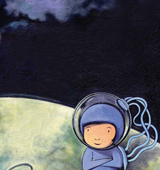There’s no one path that will lead children to writing a successful work of fiction, but you can help them to find their own way...
Over the last 30 years I have written many books for all ages, and I have yet to discover or look for a formula. Every starting point is different, but what all the books have in common is that the process of writing is a pleasurable, surprising and fulfilling journey, taken because of a keen interest in, or even obsession with, a new idea. Slowly, I let my interest in it develop by allowing myself to ‘daydream on purpose’ – that’s how one child described my way of working, and I can’t improve on it! - then by reading around the subject, visiting places, talking to people, and eventually, plunging myself into the creative whirlpool of writing.
As a professional writer I have the luxury of time inwhich to do all this. For the teacher and child in the classroom there are definite constraints, but there are ways round this which might be helpful.
...to take home, to use anywhere. Let them get used to the notion of writing every day – look at a tree, describe someone real, listen to a conversation, write it down; write, write. Like scales practised on musical instruments, steps in a dance, movement on a football pitch, these written observations form a memory bank.
 For example, the other day I worked with children who had been reading Children of Winter, (about three children who survive the Great Plague by sheltering in a barn). I took one tiny notion from it: the idea of walking away from home towards a building on a hill. It would be up to the children to discover for themselves what this building is, why the central character is going there, what he will find there, and what he has to do when he gets there. For the moment, my interest was in setting the scene.
For example, the other day I worked with children who had been reading Children of Winter, (about three children who survive the Great Plague by sheltering in a barn). I took one tiny notion from it: the idea of walking away from home towards a building on a hill. It would be up to the children to discover for themselves what this building is, why the central character is going there, what he will find there, and what he has to do when he gets there. For the moment, my interest was in setting the scene.
In three, 10 minute stages of writing, I asked children first to describe the scene – day, night, rain, sun, snow, fog, street, mountain, footpath. What difference would it make to the way their character walks, how he feels, what he wears, what he hears, etc? I kept feeding in questions of this sort as they were writing, and at the end of 10 minutes I invited six children to read out what they’d written, encouraging them by being positive about the strong words and verbs they’d used.
We then spent 10 minutes on the next phase, describing the building – castle, barn, shed, haunted house, tent, etc. – and how their character feels about it – excited, scared, curious, drawn against their will? – and again, we took time to stop, read out and discuss.
We finished with another 10 minutes of writing; the children’s character turns to have a last look towards home, and enters the building. How does he feel? What is the first thing he sees? What does he hear, touch, sense?
They must write in silence or they break someone else’s spell. The purpose of stopping every 10 minutes is to keep the writing in check, to stop children racing into a story until they’ve considered all aspects and possibilities, to give them time and confidence to use the senses, emotive language, descriptive words – and all the time the idea of a plot and story line is unfolding in their minds, but they can’t write it yet. Ideally, they don’t write any more that day, but come to it another time with fresh ideas. If it’s going to be a book, that is the end of the first chapter.
As Derbyshire’s Reading Champion, part of my brief is to encourage children in their writing and reading. Derbyshire Libraries asked me to help children to write their own books inspired by my ‘Derbyshire’ titles. The children read the books and then went to the library to explore resources. For example, with Children of Winter they investigated the history of their own village; with Blue John they visited caverns, with Deep Secret they discovered the real story of a drowned village, with A Beautiful Place for a Murder they read about legends and crimes in the Peak District. Using library resources is essential to most writers.
A rule here is to record your findings until you have a need for them, because you don’t know yet what you need to know. I would divide a notebook into letters of the alphabet, and where I read something particular or potentially useful, I would write it or reference it under the appropriate initial letter – i.e. C for Castle.
Some years ago I wrote a novel with a class of children. They wanted it to be about themselves, so it was. You could do this at your school. You can find a complete breakdown of how I worked with the class if you go to the novels/Tough Luck pages on my website (berliedoherty.com). A rule for writing for younger children is ‘never write down to your audience’. Write as if you are speaking to them, but don’t be afraid of using lively, imaginative vocabulary.
 Preferably both. If a reader is interested in the main character, they’ll want to know what happened to him. You can hot seat a character by pretending to be that person and answering questions the children ask; then let some children ‘be’ a character in the same way.
Preferably both. If a reader is interested in the main character, they’ll want to know what happened to him. You can hot seat a character by pretending to be that person and answering questions the children ask; then let some children ‘be’ a character in the same way.
The writer must ‘know’ the character, know the place. The storyline itself can be a surprise to you as the story develops, or it can be written down in six or 10 sentences, each of which is developed as a chapter. I prefer the first method; other writers prefer the second. They both work!
Essentially, a story is about the need to do something, finding a way to do it (against the odds), and the outcome. In three phases/chapters, it is about starting, problem solving, arriving. In six, the problem is nearly solved, failed, and finally solved. In nine, there are two thwarted attempts, then success.
Leave plenty of room on the page for developing, deleting, changing, adding, enriching. Always read the story aloud. Ask what worked, what might happen next. All of this helps the child writer to listen, to think, to pace their story, and to have a sense of audience.
Eleven-year-old Nicole Sharrock was one of last year’s winners and if you read her poem, Let’s Build a Rocket, you’ll understand why…
I’m building a rocket, as soon as I’m done
I’m talking my friends on a trip to the sun.
But what do you mean that the sun is too hot?
Oh well, I suppose I’ll just pick a new spot.
I’m building a rocket, I’m finishing soon
and I’m taking my friends on a trip to the moon!
But what do you mean that the moon has no air?
Oh well, I suppose I’ll just pick a new spot.
I’m building a rocket, it’s going to fly, I’m taking my friends way up high.
But what do you mean when you ask how will it land?
This rocket is harder to build than I planned.
What better way to encourage children to put pen to paper than presenting them with the opportunity to have their story published around the world? KS2 children may well have grown up reading books from the Collins Big Cat range. Now, once again, they are being given the chance to add their very own stories to the collection.
The Collins Big Cat Writing competition first began in 2010 as a means of raising achievement in primary writing and invites children aged 9–11 to let their imaginations run free. This year, the challenge is to produce a piece of free writing in poetry about a journey; or a story about an unexpected visitor that’s between 90–170 words.
The stories must be written for a child with a reading age of 5–6, which provides a great opportunity for older pupils to work collaboratively with younger children to write a story that will advance their literacy levels.
Two winners will be picked by former children’s laureate Michael Rosen and Collins Big Cat series editor, Cliff Moon. Children will also need to impress Berlie Doherty, the twice winner of the Carnegie Medal.
It’s hard to over emphasise the value of the prize as the winners will see their books published alongside those from children’s literary greats such as Michael Morpurgo, Wendy Cope and Benjamin Zephaniah. They will also benefit from being involved in the creative process of turning their story or poem into a picture book – including the whole design process from pencil drawings to choosing the final illustrated colour version.
The closing date for the competition is 10th ebruary 2011, so there’s still plenty of time for children to work on their stories. All the details you need, including a competition pack and entry form, can be downloaded from collinsbigcat.com/writing-competition.
Books to kick-start the creative process…
• Read any of the Scaredy Squirrel Books by Melanie Klein to discover an interesting character, clever plot formula and varied illustrations. These books particularly appeal to boys aged 4-6.
• You could investigate the three Tam books (The Starburster, The Humming Machine, The Windspinner) by Berlie Doherty. Each of these books is a quest story in that Tam has a particular task or problem to solve. There are also many characters to discuss and imitate. Ideal for ages 7-9.
• Tom’s Midnight Garden by Philippa Pierce is useful as a beautiful example of excellent storytelling. Read with pupils 9+.
Berlie Doherty has been a teacher and broadcaster, as well as a playwright, poet and novelist. Berlie has twice won the prestigious Carnegie Medal (berliedoherty.com).
How To Use Books To Help Children Cope With Life
Ace-English
5 friendship and emotions intervention ideas
Ace-Classroom-Support
Should you let educational researchers into your classroom?
Ace-Classroom-Support
